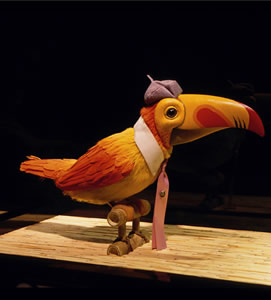Audio-Animatronics Time-Line
Early 1950s | Walt Disney purchases a mechanical bird while vacationing in Europe. The souvenir becomes the inspiration for Audio-Animatronics technology. |
1951 | Work begins on “Project Little Man.” Roger Broggie and Wathel Rogers, pioneers in Audio-Animatronicstechnology, create a miniature figure that is programmed with cams, cables and tubes to mimic tap-dancing routines performed by the late Buddy Ebsen. |
1963 | Walt Disney’s Enchanted Tiki Room opens at Disneyland. It’s the first show to feature Audio-Animatronics technology. |
1964 | The world’s first fully animated human figure, Abraham Lincoln, debuts at the New York World’s Fair in Great Moments with Mr. Lincoln. The figure causes a sensation, not just with the audience, but with Disney Imagineers, who were able to complete the figure in half the time they anticipated. Audio-Animatronics figures are also in three other World’s Fair shows designed and produced by Disney: Carousel of Progress (featuring figures animated using a programming harness, a precursor of today’s motion capture systems), Magic Skyway and it’s a small world. |
1964 | Two Audio-Animatronics birds, Robin and Umbrella, appear in “Mary Poppins.” Walt Disney reinvests profits from the film to create MAPO, an organization within Walt Disney Imagineering dedicated to creating and innovating Audio-Animatronics figures. |
1965 | Great Moments with Mr. Lincoln – featuring the Audio-Animatronics figure of Abraham Lincoln (actually, a duplicate since the original was still performing at the World’s Fair) – opens at Disneyland. |
1970 | Audio-Animatronics technology enters the computer age with the use of DACS (Digital Animation Control System), a computer-controlled playback system for Disney shows and attractions. Imagineers also begin using the Anicon-Animation Console – for animating and programming figures. |
1989 | The first A-100 Audio-Animatronics figure, the Wicked Witch of the West, debuts as part of The Great Movie Ride at Disney’s Hollywood Studios (then known as Disney-MGM Studios) in Walt Disney World Resort. A-100 figures incorporate compliance technology that gives the characters more fluid and realistic movements. |
1992 | Pirates of the Caribbean opens at Disneyland Paris. Attraction features sword-fighting pirates figures. |
1998 | Hopper, the grasshopper from the Disney•Pixar film “A Bug’s Life,” is the most sophisticated Audio-Animatronics figure produced to date. Featuring 74 functions, the character appears in “It’s Tough to be a Bug!” |
2002 | The first portable, all-electric Audio-Animatronics figure, Meeko, the raccoon from the Disney animated film “Pocahontas,” appears. He’s in a basket carried by Pocahontas. |
2003 | The first totally autonomous Audio-Animatronics figure, Lucky the Dinosaur, makes his debut, at Disney’s California Adventure. |
2006 | The yeti, a major element of Expedition Everest at Disney’s Animal Kingdom, is the largest and most powerful Audio-Animatronics figure ever created by Walt Disney Imagineering. Standing more than 18 feet tall, the thrust of the yeti’s arm has the equivalent amount of force as a 747 jumbo jet. |
2007 | The Muppet Mobile Lab, featuring Muppets Dr. Bunsen Honeydew and his assistant Beaker, marks the first time that free-roaming Audio-Animatronics characters can interact and converse with each other, as well as with guests they encounter along their way. |
2008 2009 | Mr. Potato Head in Toy Story Mania! at both Disney’s California Adventure and Disney’s Hollywood Studios marks the first time that anAudio-Animatronics figure features lips with such a wide range of lifelike movements, can remove and re-attach a body part (his ear) and has digitally animated eyes that can look directly at the particular guest with whom he is conversing. Also, since Mr. Potato Head has more lines of dialogue than any Audio-Animatronics figure ever created by Walt Disney Imagineering, it has required more programming hours than any other figure. Chef Remy, the lovable star of the Disney/Pixar film "Ratatouille," who is the smallest Audio-Animatronics in the world, is appearing six days a week, four times a day at Les Chefs de France in the France pavilion at Epcot. |













